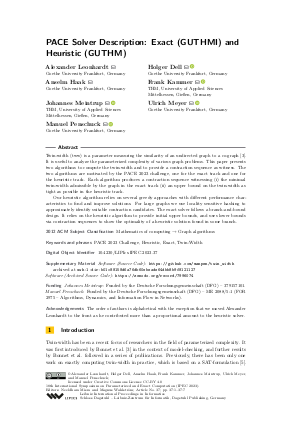PACE Solver Description: Exact (GUTHMI) and Heuristic (GUTHM)
Authors
Alexander Leonhardt,
Holger Dell  ,
Anselm Haak,
Frank Kammer
,
Anselm Haak,
Frank Kammer  ,
Johannes Meintrup
,
Johannes Meintrup  ,
Ulrich Meyer
,
Ulrich Meyer  ,
Manuel Penschuck
,
Manuel Penschuck 
-
Part of:
Volume:
18th International Symposium on Parameterized and Exact Computation (IPEC 2023)
Part of: Series: Leibniz International Proceedings in Informatics (LIPIcs)
Part of: Conference: International Symposium on Parameterized and Exact Computation (IPEC) - License:
 Creative Commons Attribution 4.0 International license
Creative Commons Attribution 4.0 International license
- Publication Date: 2023-12-13
File

PDF
LIPIcs.IPEC.2023.37.pdf
- Filesize: 0.61 MB
- 7 pages
Document Identifiers
Subject Classification
ACM Subject Classification
- Mathematics of computing → Graph algorithms
Keywords
- PACE 2023 Challenge
- Heuristic
- Exact
- Twin-Width
Metrics
- Access Statistics
-
Total Accesses (updated on a weekly basis)
0PDF Downloads0Metadata Views
Abstract
Twin-width (tww) is a parameter measuring the similarity of an undirected graph to a co-graph [Édouard Bonnet et al., 2022]. It is useful to analyze the parameterized complexity of various graph problems. This paper presents two algorithms to compute the twin-width and to provide a contraction sequence as witness. The two algorithms are motivated by the PACE 2023 challenge, one for the exact track and one for the heuristic track. Each algorithm produces a contraction sequence witnessing (i) the minimal twin-width admissible by the graph in the exact track (ii) an upper bound on the twin-width as tight as possible in the heuristic track. Our heuristic algorithm relies on several greedy approaches with different performance characteristics to find and improve solutions. For large graphs we use locality sensitive hashing to approximately identify suitable contraction candidates. The exact solver follows a branch-and-bound design. It relies on the heuristic algorithm to provide initial upper bounds, and uses lower bounds via contraction sequences to show the optimality of a heuristic solution found in some branch.
Cite As Get BibTex
Alexander Leonhardt, Holger Dell, Anselm Haak, Frank Kammer, Johannes Meintrup, Ulrich Meyer, and Manuel Penschuck. PACE Solver Description: Exact (GUTHMI) and Heuristic (GUTHM). In 18th International Symposium on Parameterized and Exact Computation (IPEC 2023). Leibniz International Proceedings in Informatics (LIPIcs), Volume 285, pp. 37:1-37:7, Schloss Dagstuhl – Leibniz-Zentrum für Informatik (2023)
https://doi.org/10.4230/LIPIcs.IPEC.2023.37
BibTex
@InProceedings{leonhardt_et_al:LIPIcs.IPEC.2023.37,
author = {Leonhardt, Alexander and Dell, Holger and Haak, Anselm and Kammer, Frank and Meintrup, Johannes and Meyer, Ulrich and Penschuck, Manuel},
title = {{PACE Solver Description: Exact (GUTHMI) and Heuristic (GUTHM)}},
booktitle = {18th International Symposium on Parameterized and Exact Computation (IPEC 2023)},
pages = {37:1--37:7},
series = {Leibniz International Proceedings in Informatics (LIPIcs)},
ISBN = {978-3-95977-305-8},
ISSN = {1868-8969},
year = {2023},
volume = {285},
editor = {Misra, Neeldhara and Wahlstr\"{o}m, Magnus},
publisher = {Schloss Dagstuhl -- Leibniz-Zentrum f{\"u}r Informatik},
address = {Dagstuhl, Germany},
URL = {https://drops.dagstuhl.de/entities/document/10.4230/LIPIcs.IPEC.2023.37},
URN = {urn:nbn:de:0030-drops-194563},
doi = {10.4230/LIPIcs.IPEC.2023.37},
annote = {Keywords: PACE 2023 Challenge, Heuristic, Exact, Twin-Width}
}
Author Details
Funding
- Meintrup, Johannes: Funded by the Deutsche Forschungsgemeinschaft (DFG) - 379157101.
- Penschuck, Manuel: Funded by the Deutsche Forschungsgemeinschaft (DFG) - ME 2088/5-1 (FOR 2975 - Algorithms, Dynamics, and Information Flow in Networks).
Acknowledgements
The order of authors is alphabetical with the exception that we moved Alexander Leonhardt to the front as he contributed more than a proportional amount to the heuristic solver.
Supplementary Materials
-
Software (Source Code)
https://github.com/manpen/twin_width
browse
 archived version
archived version
- Software (Archived Source Code) https://zenodo.org/record/7996074
References
- Pierre Bergé, Édouard Bonnet, and Hugues Déprés. Deciding twin-width at most 4 is np-complete. In ICALP 2022, volume 229 of LIPIcs, pages 18:1-18:20, 2022. URL: https://doi.org/10.4230/LIPIcs.ICALP.2022.18.
- Édouard Bonnet, Eun Jung Kim, Amadeus Reinald, Stéphan Thomassé, and Rémi Watrigant. Twin-width and polynomial kernels. Algorithmica, 2022. URL: https://doi.org/10.1007/s00453-022-00965-5.
- Édouard Bonnet, Eun Jung Kim, Stéphan Thomassé, and Rémi Watrigant. Twin-width I: tractable FO model checking. J. ACM, 69(1):3:1-3:46, 2022. URL: https://doi.org/10.1145/3486655.
- A. Broder. On the resemblance and containment of documents. In Proceedings of the Compression and Complexity of Sequences 1997, SEQUENCES '97, page 21, USA, 1997. IEEE. URL: https://doi.org/10.1109/SEQUEN.1997.666900.
- André Schidler and Stefan Szeider. A SAT approach to twin-width. In ALENEX 2022, pages 67-77. SIAM, 2022. URL: https://doi.org/10.1137/1.9781611977042.6.
